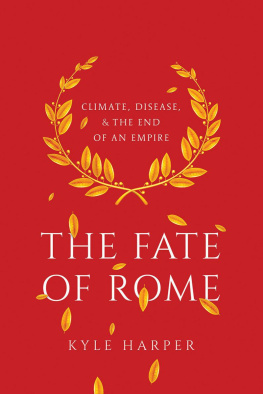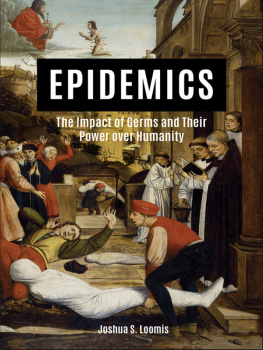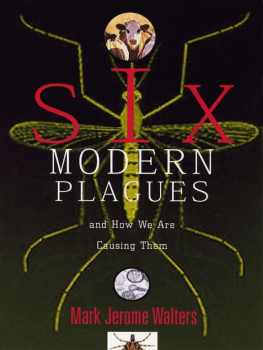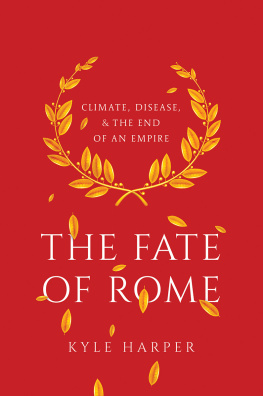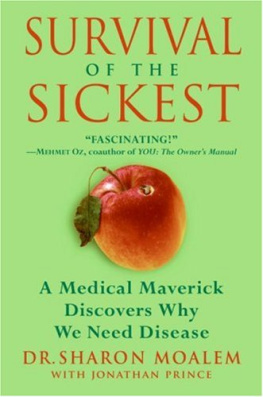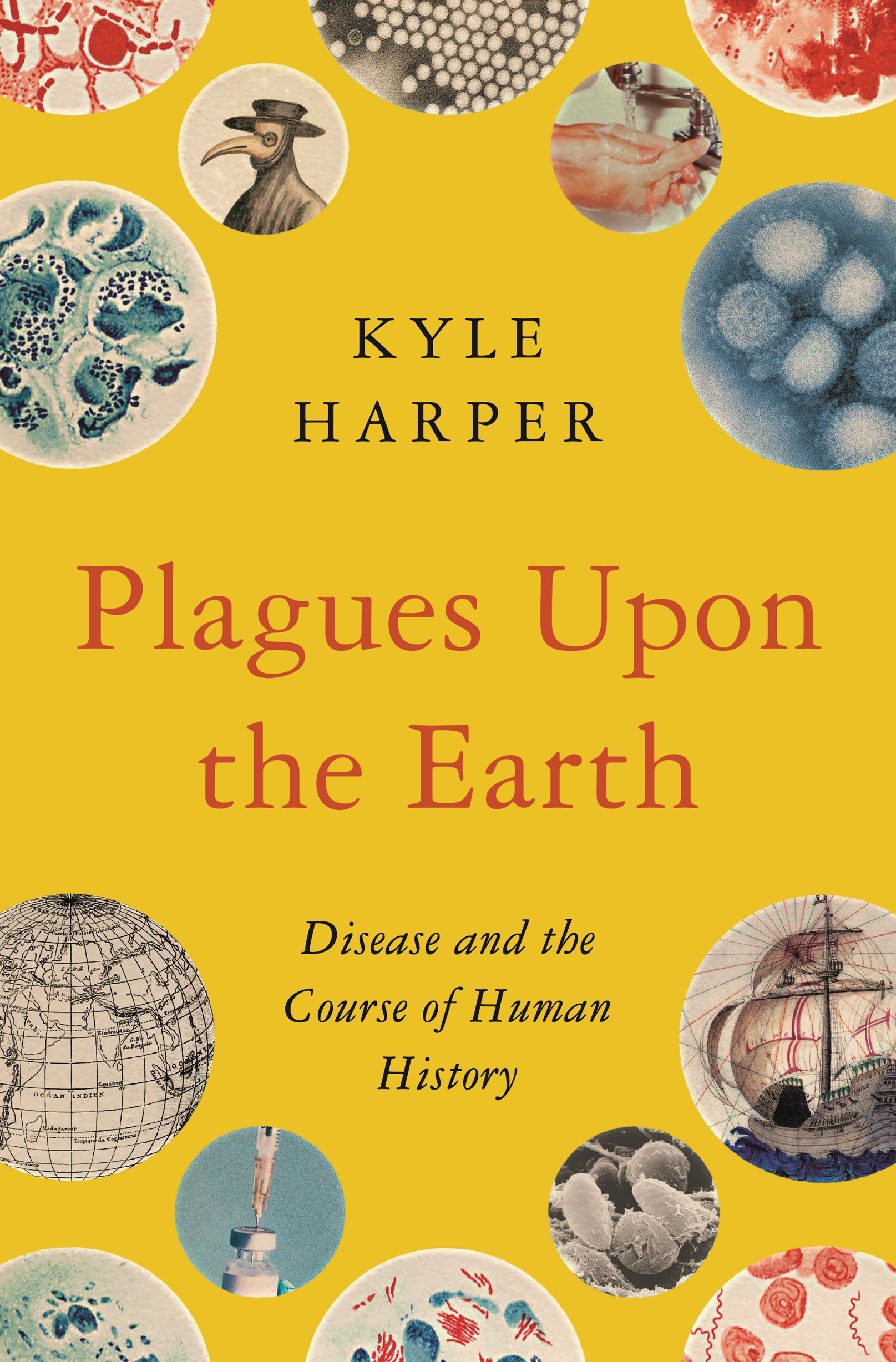PLAGUES UPON THE EARTH
THE PRINCETON ECONOMIC HISTORY OF THE WESTERN WORLD
Joel Mokyr, Series Editor
A list of titles in this series appears in the back of the book.
Plagues Upon the Earth
DISEASE AND THE COURSE OF HUMAN HISTORY
KYLE HARPER
PRINCETON UNIVERSITY PRESS
PRINCETON & OXFORD
Copyright 2021 by Princeton University Press
Princeton University Press is committed to the protection of copyright and the intellectual property our authors entrust to us. Copyright promotes the progress and integrity of knowledge. Thank you for supporting free speech and the global exchange of ideas by purchasing an authorized edition of this book. If you wish to reproduce or distribute any part of it in any form, please obtain permission.
Requests for permission to reproduce material from this work should be sent to .
Published by Princeton University Press
41 William Street, Princeton, New Jersey 08540
6 Oxford Street, Woodstock, Oxfordshire OX20 1TR
press.princeton.edu
All Rights Reserved
Library of Congress Cataloging-in-Publication Data
Names: Harper, Kyle, 1979 author.
Title: Plagues upon the earth : disease and the course of human history / Kyle Harper.
Description: Princeton : Princeton University Press, [2021] | Series: The Princeton economic history of the western world; 46 | Includes bibliographical references and index.
Identifiers: LCCN 2021012798 (print) | LCCN 2021012799 (ebook) | ISBN 9780691192123 (hardback) | ISBN 9780691224725 (ebook)
Subjects: LCSH: EpidemicsHistory. | PlagueHistory. | Disease and history. | BISAC: HISTORY / Social History | MEDICAL / Infectious Diseases
Classification: LCC RA649 .H274 2021 (print) | LCC RA649 (ebook) | DDC 614.4/9dc23
LC record available at https://lccn.loc.gov/2021012798
LC ebook record available at https://lccn.loc.gov/2021012799
Version 1.0
British Library Cataloging-in-Publication Data is available.
Editorial: Rob Tempio, Matt Rohal
Jacket Design: Karl Spurzem
Production: Erin Suydam
Publicity: James Schneider, Amy Stewart
Copyeditor: Ingrid Burke
For Sylvie, August, Blaise, Max, and Michelle
This new world may be safer, being told
The dangers and diseases of the old;
For with due temper men do then forgo,
Or covet things, when they their true worth know.
There is no health; physicians say that we
At best enjoy but a neutrality.
And can there be worse sickness than to know
That we are never well, nor can be so?
JOHN DONNE, AN ANATOMY OF THE WORLD (1611)
TABLE OF CONTENTS
PLAGUES UPON THE EARTH
Introduction
MICROORGANISMS AND MACROHISTORY
ONE OF THE CHIEF BLESSINGS of living in the modern world is supposed to be that the risk of dying from an infectious disease has become vanishingly small. The nuisances of modern civilization are a small price to pay for the good fortune of being alive at a time when our germs have been brought to heel. We can grudgingly resign ourselves to the inevitability that cancers, chronic diseases, or degenerative disorders will catch up to us someday. We moderns die of old age, of overabundance, of cellular malfunction but not plagues and poxes. Until, that is, a new pestilence has the temerity to disrupt our daily lives, here and now.
More than we are apt to remember, even in the shadow of a pandemic, the world we inhabit thoroughly presupposes the subjugation of infectious disease. Consider, if you are privileged enough to live in a developed society, a routine morning. It starts with a walk across a cold (but easily disinfected) tile floor to deposit roughly one hundred grams of stool in a gravity-powered flushing device. A few liters of water, carrying nine trillion or so bacteria, are whisked away for treatment. A thin, two-ply tree product minimized contact between your waste and your hands, but for good measure you wash them anyway, using soap containing mild antibiotic compounds. In the shower you douse your whole body with gentle disinfectants, and then apply a jelly loaded with an aluminum compound to waylay the malodorous bacteria in your underarms.
When you walk into the kitchen, you open a refrigerated box and feel the 40F air rush outjust cool enough to slow the decay of the dead fruits, vegetables, and animals inside. You grab (on a weekend morning, perhaps) some slices of slaughtered pig, tightly wrapped in an impermeable sheet of cellulose that keeps bacteria and oxygen out. Using one of the very oldest technologies, you light a fireor at least twist a knob that does it for youand heat your meat until it is around 150F, and the microbes hanging all over it are good and dead. When you drink a glass of water, the fact that it has been mildly chlorinated upstream of your faucet relieves you of any need to worry that you will contract a ghastly intestinal disease. And should you pour yourself a glass of cows milk, you can be assured that any microbial stowaways were exterminated in a process developed by the father of germ theory himself, Louis Pasteur.
Belly appeased, you leave the house owned by the bank that made you a thirty-year loan on the safe bet that you will be alive long enough to pay the money back. You depart through a door that is sealed to keep out rodents, mosquitos, and other carriers of pathogens. Perhaps you load your kids (on average, just over two of them) into the van, taking them to a school where they spend more than a decade sponging up knowledge for a future they fully expect to see. Thankfully, it is safe to put your darlings in a building with hundreds of other humans because they have immune systems artificially primed by vaccines to withstand a whole array of half-forgotten diseases. You accept, and bear gracefully, the seasonal colds and sore throats that are the price of existence on a crowded planet.
Our whole way of life depends on the control of infectious disease. But the dominance of Homo sapiens over its microbial enemies is astonishingly recent. Throughout most of human history, pathogens and parasites held the upper hand. Infectious diseases were the leading cause of death into the twentieth century. There have been about ten thousand generations of humans so far. For all but the last three or four generations, life was short, lasting on average around thirty years. Yet this average is deceptive, because life in a world ruled by infectious disease was both short and uncertain. Infectious diseases came in steady drips and in massive unforeseen waves. The control of infectious disease thus did more than double the average human lifespan. It changed our most basic expectations about suffering and predictability.
Humanitys control is not only recent. It is also incomplete, in at least two senses. First, it is geographically uneven. In large parts of the world, infectious diseases remain an everyday threat. The freedom from fear of pestilence is a privilege not uniformly shared around the planetan insidious fact whose history this book seeks to retrace. Second, our control of infectious disease is fragile. The tools we possess to mitigate the risks of infectious disease are many and clever, but they are also imperfect. Meanwhile, the evolution of new threats not only continues but accelerates, as human numbers rise and as we put pressure on natural ecosystems. For a parasite, there is now more incentive to exploit humans than ever. We do not, and cannot, live in a state of permanent victory over our germs. Eternal vigilance is the price of liberation from infectious disease, but interruptions are inevitable, not anomalous.


